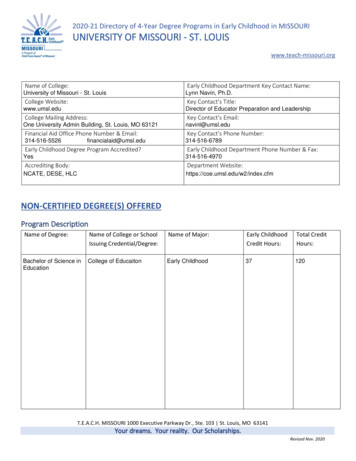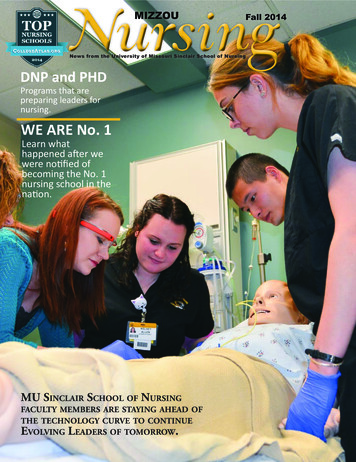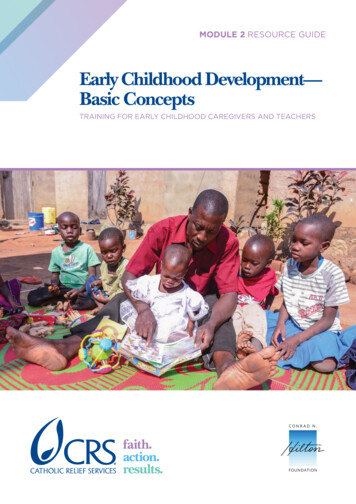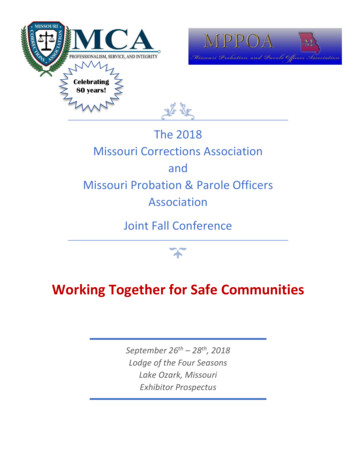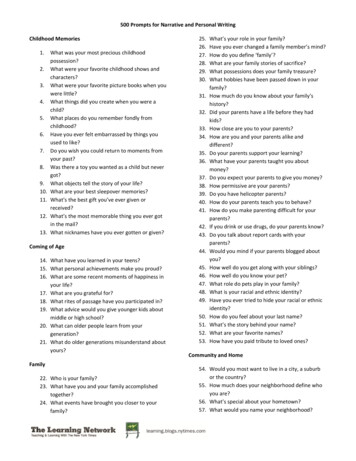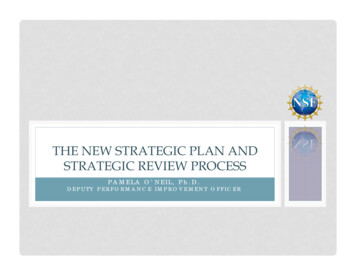
Transcription
Missouri’sEarly ChildhoodStrategic PlanMissouriCoordinatingBoard for EarlyChildhoodDeveloped inpartnership with theEarly ChildhoodComprehensive System1 Page
VisionAll young children in Missouri are safe, healthy and capable of reaching their full potential.MissionTo ensure that Missouri’s early childhood programs and services are comprehensive, coordinated,accessible, adequately funded, and of the highest quality to meet the needs and to promote the wellbeing of all young children and their families. This can be accomplished by (a) developing keypartnerships, (b) building collaborative strategies, (c) ensuring equal access to necessary resources,resulting in the implementation of an effective and sustainable early childhood system, and (d) beingcompliant with all applicable federal and state law including but not limited to §161.216 RSMo.Guiding PrinciplesThe priorities and strategies employed by the Coordinating Board for Early Childhood (CBEC) inachieving its mission reflect a core set of values: Early childhood is the life period of most intensive development where both positive andnegative factors have the greatest impact.Effective programs for young children respond to the totality of a child’s development, not justone aspect.Children with disabilities or other special needs are best served in natural environments andinclusive programs, rather than separate, clinical, or disability-focused settings.Family involvement and engagement is essential to meeting the needs of young children;effective early childhood programs invite and support parents as fully engaged partners in thedesign and delivery of services.High quality programs that are informed by research are the most effective.Practices, programs, and professionals are culturally responsive, inclusive and accessible to allchildren.Investments in prevention and early intervention are the most cost effective use of publicfunds.The coordination of programs and services across the state, communities and agencies resultsin administrative efficiencies, greater impact of services and more convenience for families.2 Page
InfrastructureThe following outcomes are critical to the development of a comprehensive early childhood system andintegral to the achievement of desired outcomes for children. Goals for an effective infrastructure arestated under each component.Governance and LeadershipDesired Outcome: The governance and leadership of Missouri’s early childhood system supports a coordinatedand comprehensive system among all relevant departments and entities.Goals:1. Missouri public policies ensure a comprehensive and integrated early childhood system, built on afoundation of collaborative governance and leadership at the state and local levels.2. The governance structure supports coordination and collaboration for an integrated comprehensivesystem.3. The governance structure ensures accountability within and among components of the system.4. Missouri’s integrated early childhood system incorporates family leadership at all levels.Objectives:1. Develop a system for advancing family leadership that includes training, mentoring, and linkage offamilies with diverse leadership opportunities.2. Develop a system for family participation in decision-making across the early childhood system.3. Decisions regarding key elements of a comprehensive early childhood system are addressedcollaboratively.Financial ResourcesDesired Outcome: Missouri’s early childhood system is supported by adequate and sustainable financialresources.Goals:1. Sustainable funding supports a comprehensive early childhood system.2. Fiscal resources are coordinated from federal, state, and local sources, both public and private, to ensurethe most effective, efficient and accountable use of funds.3. Funding guidelines are conducive to cross-department collaborations.4. Financial resources support access to programs, services and leadership opportunities for all Missouri’sfamilies.Objectives:1. Business leaders have a means to mobilize their support for early childhood.2. Promote the increase of accountability for the usage of subsidy funds.3. Increase accountability for the usage of subsidy funds for unregulated child care.Quality Assurance and AccountabilityDesired Outcome: Quality assurance and accountability is integrated into andthroughout Missouri’s Early Childhood System.Goals:1. Missouri state policies, regulations, rules, and early learning andprogram standards strengthen quality by utilizing national and stateidentified standards and evidence-based practices.2. Families have access to information about the quality of all programsfor young children.3. Reliable data inform all policy decisions.4. State and local communities use cross-sector data for planning,analysis, decision-making, and evaluation.5. Missouri’s professional development system for early childhood andyouth assures professionals are competent and qualified.3 Page
Objectives:1. As state regulations and rules are revised, ensure inclusion of appropriate national standards andevidence-based practices.2. Evaluations of programs and services are available to the public.3. Propose a coordinated administrative structure for early childhood professional development services.Public EngagementDesired Outcome: The public is actively engaged and invested in the well-being of Missouri’s young children andfamilies.Goals:1. State and local policy-makers support greater investments in programs for young children and families.2. Public advocacy and voter support promote greater investment in early childhood at the state and locallevels.3. Stakeholders deliver a consistent message regarding the needs of children and families in Missouri.Objectives:1. Promote creation of a state-wide public education campaign to raise awareness of issues of the wellbeing of young children and families.Desired Outcomesfor Young ChildrenMissouri’s system of early childhood programs and services is agroup of interacting, interrelated and interdependentcomponents that form a complex and unified whole. A primarypurpose of this system is to promote school readiness amongchildren, families, programs, and communities.Family SupportDesired Outcome: Missouri’s young children have their basic needs met.Goals:1. Missouri’s state and local policies support the basic needs of all families with young children.2. Communities recognize, support, and respond proactively to the diversity of Missouri’s families.3. Missouri’s communities ensure that preventive and intervention services are accessible to meet a rangeof family needs.4. Missouri’s families meet the basic safety and subsistence needs of the young children in their care.Objectives:1. Develop a system of family support that enhances protective factors in families.Long-Term Activities:1. Promote creation of a system that is responsive to emergency needs and promotes continued familystability.2. Partner to support the implementation of statewide family leadership opportunities.3. Promote and support the Strengthening Families approach throughout Missouri.4 Page
Parenting EducationDesired Outcome: Supportive and nurturing family environments for Missouri’s young children are enhanced bythe integration of parenting education into the early childhood system.Goals:1. Policies and programs at the state and local levels foster nurturing family environments that benefitchildren.2. Community agencies and programs effectively engage families in ways that support their parenting.3. Missouri’s families have the skills and access to programs and resources they need to facilitate theirchild(ren)’s growth and development.4. Parenting education programs and services help parents develop the skills and knowledge necessary tosupport school readiness.Objectives:1. Parents have opportunities to observe, guide and promote the learning of their children at home, schooland in the community.2. Parents participate in ongoing support, education and skill development opportunities that promotewarm, healthy parent/child relationships.Long-Term Activities:1. Develop and coordinate effective parenting initiatives that advance parenting and parents’ knowledge ofchild development.2. Support an in-depth analysis of existing parenting education and home visiting programs to ensure thatthey employ best practices and are serving families most in need.Early Childhood ProgramsDesired Outcome: Missouri’s children have access to high quality early childhood programs.Goals:1. Missouri state policies establish a seamless system of early learning programs from birth to kindergartenentry.2. Missouri state child care assistance policies ensure availability of affordable child care throughout thestate.3. Missouri early learning guidelines and standards provide guidance to all programs serving young children.4. Missouri state policies support an integrated system of professional development, education and training,which ensures that professionals in all components of the systems are knowledgeable, skilled andcompensated appropriately.5. Missouri’s state policies promote the continuous improvement of quality in early childhood programs.Objectives:1. Early learning programs include an array of homevisiting and group care settings that meet the needsof Missouri’s young children and families.2. Policies and practices support effective transitions forchildren and families across programs and systems,reflecting an understanding of children’s needsthroughout the continuum from prenataldevelopment through third grade.3. Child care assistance funding is increased to assureavailability and stability of quality services and serviceproviders for all of Missouri’s children and families.4. A comprehensive, coordinated system of professional development serves both early childhood andschool-age professionals across settings.5 Page
5. Professional development services are culturally responsive, inclusive and accessible to all relatedpersonnel in the early childhood system.6. All programs use the Missouri early learning guidelines and standards for providing services to children asthe foundation for program development.7. Missouri state policies develop a mechanism for early childhood programs to access coaching, resourcesand other supports to improve quality.Long-Term Activities:1. Program transitions from prenatal care through early elementary grades are examined to determine thegaps that disrupt the early learning experiences for young children or families.2. Support opportunities for blended funding, collaborative planning, and program standards that improvechildren’s transitions.3. Develop a statewide publicly-funded voluntary pre-k program for all Missouri children available two yearsprior to kindergarten.4. Promote availability of state-wide evidence-based home visiting programs.5. Support implementation of recommendations regarding degrees, articulation, and certification of allrelated personnel in the early childhood system.6. Investigate and support the implementation of professional development activities that support effectiveinclusion of children with disabilities in early childhood and school-age environments.7. Research strategies and make recommendations for the recruitment, retention, and promotion of aculturally diverse workforce.8. Support the increase of subsidy reimbursements for licensed care to expand family access.9. Support the development and implementation of new rules for licensed family child care and licenseexempt child care centers.10. Assure appropriate health and safety provisions are embedded into the revised child care licensingregulations for all provider types.11. Develop and disseminate information that clearly articulates the need for and the benefit of a pre-Kprogram in Missouri.HealthDesired Outcome: Missouri’s children have a source ofcoordinated, comprehensive and family-centered primaryhealth care and services.Goals:1. Principles promoting health and wellness foryoung children and families are integrated into allaspects of Missouri’s early childhood system.Objectives:1. Missouri’s state policies support the medical homemodel.2. Missouri’s community health care providers areaccessible and knowledgeable, and they readilyshare information with families about availableservices and resources.3. Missouri’s early childhood programs and services promote health and wellness, addressing such areas asnutrition, obesity and safety.4. Missouri’s families are health literate and actively participate in decision-making regarding the health andwellness of their children.6 Page
Long-Term Activities:1. Support a statewide system of child care health consultation to provide health and safety consultationand education to child care providers.2. Assure all Missouri children and their parents (especially children birth-5 years) have access to affordablepublic or private health insurance.3. Assure all Missouri children have access to healthcareoffered at hours and locations that are convenient fortheir families.4. Support and enhance care provided by rural healthproviders.5. Assure health care provider reimbursement rates aresufficient to ensure availability of an adequate numberof providers.6. Implement best practice standards and protocols forscreening young children, including the use ofculturally appropriate tools and processes.7. Develop a long-term coordinated plan for all pregnantwomen to have access to a home visiting program.8. Develop and maintain a system of periodic population-based statewide needs assessment measuring theextent to which families access a medical home.Mental Health and Social-Emotional DevelopmentDesired Outcome: Missouri’s children are socially and emotionally healthy.Goals:1. Principles promoting social and emotional wellness for young children and families are integrated into allaspects of Missouri’s early childhood system.Objectives:1. State and local policies in Missouri support the emotional well-being of families and children.2. Collaborative efforts in communities identify social, emotional and behavioral risks and intervene toprevent more serious mental health problems.3. Missouri’s families provide a socially and emotionally healthy home environment.Long-Term Activities:1. Facilitate the development of a collaborative system of infant/early childhood mental health consultation.2. Ensure that best practice standards and protocols for screening young children for emotional, social andbehavioral risk factors, including the use of culturally appropriate tools and processes, are integrated intothe comprehensive early childhood system.3. Integrate mental health training into pre- and in-service programs for early childhood personnel.4. Implement a statewide campaign to increase awareness of the importance of social and emotional wellbeing.7 Page
Glossary Child Care Health Consultation – (from the Missouri Department of Health and Senior Services) The Missouri ChildCare Health Consultation (CCHC) Program is a collaborative project between the Missouri Department of Healthand Senior Services and the local public health agencies (LPHAs) throughout Missouri to provide healthconsultation and training services to child care providers. The program is a population-based initiative thatreached almost 79,000 preschool aged children in Federal Fiscal Year 2010. The CCHC Program is based on anursing model practice that uses registered professional nurses to oversee and deliver programs that focus onhealth, safety and nutrition in the child care setting. Desired Outcomes – the desired end state for this component of the early childhood system in Missouri. Early Childhood – the period of life extending from birth to age 8 years. Early Learning Programs – the array of programs designed to support the learning, development, and schoolreadiness of young children, including those delivered in group settings and home-based. Early Learning Standards- statements that describe expectations for the learning and development of youngchildren across the domains of health and physical well-being, social and emotional well-being, approaches tolearning, language development and symbol systems, and general knowledge about the world around them. Evidence-based – research on a particular intervention, practice or model has demonstrated that the practice iseffective in meeting its goals. Family Support – community-based services designed to promote the well-being of children and families. Goals – attainments related to outcomes for children, for families, for communities, and for the State that areachievable. Group settings – child care or preschool settings in which groups of children are cared for by responsible adults.Group settings encompass licensed or accredited centers, family child care homes and unregulated, or family,friend and neighbor (FFN) care. Home Visiting – a prenatal, infant and early childhood health and development approach in which the designassumes home visits with parents as the primary method for delivering a service or intervention, and throughwhich an ongoing relationship is developed with enrolled families over time. Inclusion – early childhood inclusion embodies the values, policies, and practices that support the right of everyinfant and young child and his or her family, regardless of ability, to participate in a broad range of activities andcontexts as full members of families, communities and society. The desired results of inclusive experiences forchildren with disabilities and their families include a sense of belonging and membership, positive socialrelationships and friendships, and development and learning to reach their full potential. The defining features ofinclusion that can be used to identify high quality early childhood programs and services include (1) access, (2)participation and (3) supports. Long-term activities – actions or initiatives aimed at supporting goals and objectives anticipated to take one tothree years to accomplish. Medical home – primary care that is accessible, continuous, comprehensive, family-centered, coordinated,compassionate, and culturally effective. Objectives – more detailed attainments to occur within a three-year time frame. Parents – primary caregivers of young children, including grandparents, non-custodial parents and foster parents. Parenting education – formal and informal services that are designed to enhance competence and confidence inparenting practices that support and nurture healthy child development.8 Page
Professional development – (from the National Association of Child Care Resource & Referral Agencies) EarlyChildhood Education Professional Development is a continuum of learning and support activities designed toprepare individuals for work with and on behalf of young children and their families, as well as ongoingexperiences to enhance this work. These opportunities lead to improvements in the knowledge, skills, practicesand dispositions of early education professionals. Professional development encompasses education, training, andtechnical assistance. School readiness – (from the Department of Elementary and Secondary Education) School readiness is acombination of readiness among children, families, schools and communities: For children, school readiness means being prepared in key dimensions of early learning anddevelopment (social and emotional, language and literacy, cognitive, motor, health and physical wellbeing, and positive attitudes and behaviors toward learning). For families, it means an understanding of their children’s current level of development and how toencourage them, as well as a supportive partnership with the school and an understanding of the schoolsystem their children will enter. For schools, it means providing a welcoming and accepting environment for all children and havingprofessional educators who consistently advance student growth and achievement while working inpartnership with families. For communities, it means supporting schools, families and valuing the critical role of early learning. Transition –refers to each programmatic transition for a child and family during early childhood. The aim is for allchildren to effectively transition from the home (even when the child is not enrolled in an early childhoodprogram) and every type of early childhood program (e.g., both home-based and center-based programs, bothpublicly and privately funded early childhood programs, faith-based programs, home visitation programs, EarlyHead Start, Parents as Teachers, First Steps, and early childhood special education). Collaborative planning acrossagencies and programs should result in the child’s successful transition into kindergarten and each subsequentearly elementary grade level in both public and private schools. Voluntary pre-k – a preschool program that is universally available, but voluntary to families. A Missouri Pre-Kprogram will serve children two years prior to kindergarten entry, and will include a sliding scale fee structure. PreK will be available through any center- or family-based program (e.g., public, private, for-profit, non-profit andfaith-based) that meets standards established for the program.9 Page
3. Missouri early learning guidelines and standards provide guidance to all programs serving young children . 4. Missouri state policies support an integrated system of professional development, educatio n and training, which ensures that professionals in all components of the systems are knowledgeable, skilled and compensated appropriately . 5.
